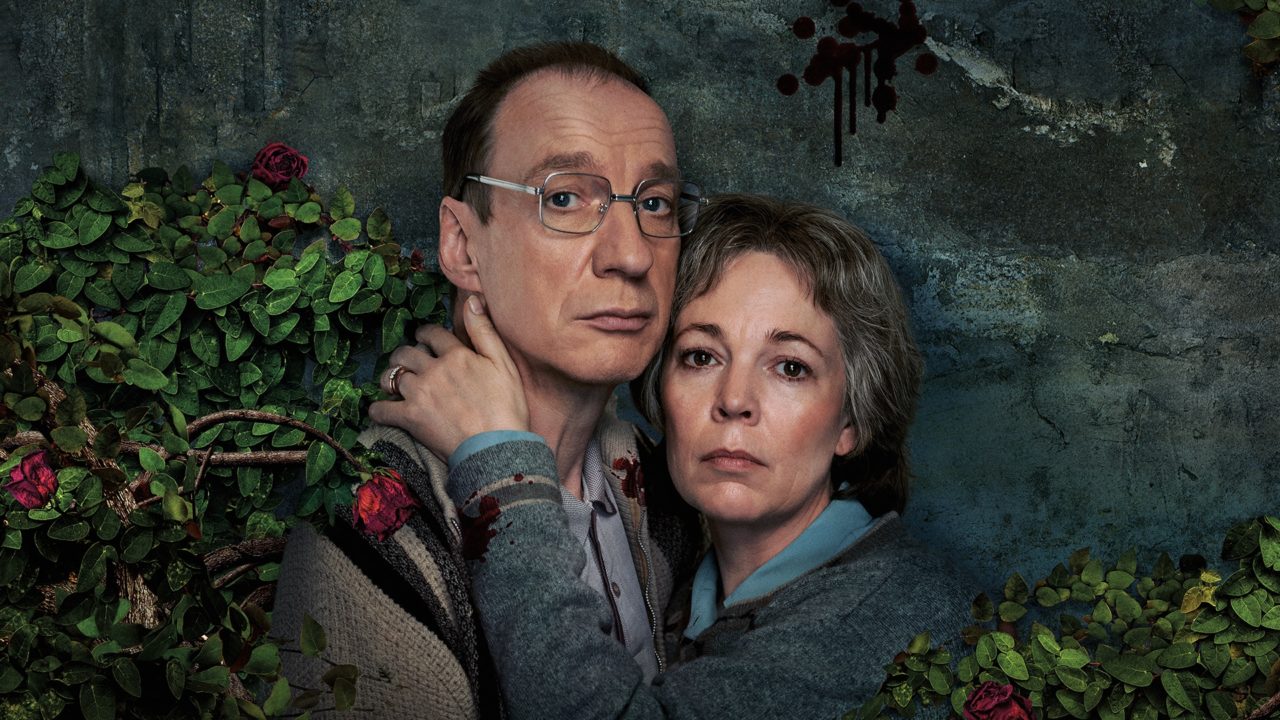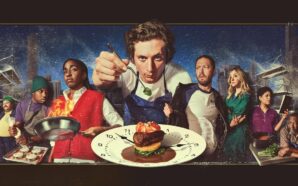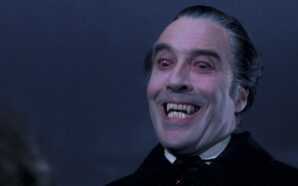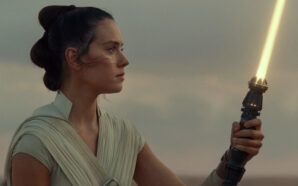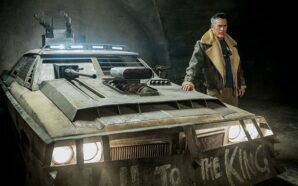Amid a deluge of prestige true crime dramas, Landscapers vows to carve out its own identity by being different. But is it trying too hard? In telling the story of Susan and Christopher Edwards, and their murder of Susan’s parents, Landscapers employs fourth wall breaks, black-and-white flashbacks, blurred edges of the frame, grainy 4:3 footage, Super 8 footage, stage play elements, scenes lit by a variety of coloured lights, impressionistic fantasy scenes, genre-bending sequences shot like old movies, and so much more across 4 relatively short episodes. Every possible stylistic technique is utilised by writer Ed Sinclair and director Will Sharpe to varying degrees of success, many of which are genuinely cleverly employed, but one gets the sense the filmmakers’ motivation is often to be clever rather than tell a narrative.
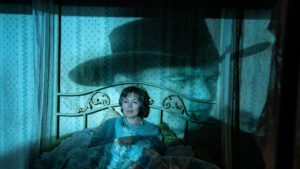 The visuals of Landscapers may be unique but the themes are not. The miniseries opens with the statement “this is a true story” and the word ‘true’ fading away before the others. Where else have we seen this? Fargo, of course. Landscapers shares much in common with the third season of the American series, most prominently the thematic exploration of the battle between subjective and objective truth, as well as the casting of David Thewlis. Fargo is unafraid to mix up its visuals to aid its narrative, but usually it’s season-by-season, episode-by episode. Landscapers seeks to best it by reinventing its visual style on a scene-by-scene basis, transitioning so frequently that it sets itself up to fail. No one show can succeed at so many styles and, frustratingly, the end result is an intriguing mixed bag of brilliant sequences and creative decisions and distracting, self-important flourishes.
The visuals of Landscapers may be unique but the themes are not. The miniseries opens with the statement “this is a true story” and the word ‘true’ fading away before the others. Where else have we seen this? Fargo, of course. Landscapers shares much in common with the third season of the American series, most prominently the thematic exploration of the battle between subjective and objective truth, as well as the casting of David Thewlis. Fargo is unafraid to mix up its visuals to aid its narrative, but usually it’s season-by-season, episode-by episode. Landscapers seeks to best it by reinventing its visual style on a scene-by-scene basis, transitioning so frequently that it sets itself up to fail. No one show can succeed at so many styles and, frustratingly, the end result is an intriguing mixed bag of brilliant sequences and creative decisions and distracting, self-important flourishes.
When the visual style succeeds it’s because it is conveying the perspective of its lead characters. Susan and Christopher are film obsessives and view their traumatic life experiences, and crimes, as cinematic sequences, retreating into the fantasy. These moments are fantastic and the series makes the effort to commit to their point of view rather than mock it. These scenes, whether western or romantic, offer drama, insight into the characters, and enjoyable quirk and dark comedy. The show itself is unconcerned which narrative, whether the police’s or Susan and Christopher’s, is true. It embraces subjective perspective, with Susan’s broken nature often described as “alien”, and the truth gets in the way of this, often disrupting the visual storytelling as well as the narrative in interesting ways.
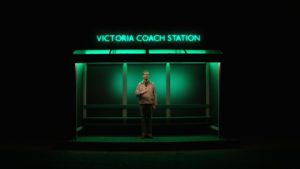 The middle two episodes are structured around police interviews, which allows for the most experimental sequences of the show. Susan’s recollections can be shown like an old black-and-white film allowing the police to break the fourth wall of the movie in her mind, as well as that of the show itself, to try and get to the truth. Christopher’s story, which holds little truth or detail, is performed on minimalist sets in a black void, literal holes in the presentation of the story representing the holes in the story itself. Nothing but a framework of a clear lie. Within these interview-induced scenes, every trick Landscapers employs has purpose. It’s outside of these sequences, largely in the first and final episodes, where the issues lie.
The middle two episodes are structured around police interviews, which allows for the most experimental sequences of the show. Susan’s recollections can be shown like an old black-and-white film allowing the police to break the fourth wall of the movie in her mind, as well as that of the show itself, to try and get to the truth. Christopher’s story, which holds little truth or detail, is performed on minimalist sets in a black void, literal holes in the presentation of the story representing the holes in the story itself. Nothing but a framework of a clear lie. Within these interview-induced scenes, every trick Landscapers employs has purpose. It’s outside of these sequences, largely in the first and final episodes, where the issues lie.
The show has to remove itself from Christopher and Susan’s perspective for some standard police scenes but the filmmakers don’t want to say goodbye to the quirkiness and visual flair. Therefore, for no narrative reason, there’s weird humour of an angry police chief, jaunty comedy music during a house call, and annoying blurred edges of the frame in almost every single scene. The police are played as malicious during scenes featuring Christopher and Susan to fit their point of view, and to create sympathy for the killers, but outside of those scenes, the officers are goofballs themselves, characters in their own warped series, which lessens the impact of the perspective storytelling. If the scenes outside of the two lead characters (it’s difficult to call them protagonists) were played straight then it would create a fascinating dichotomy but, as it stands, the show wants to have its cake and eat it too. What makes it more apparent and frustrating is that some of the best scenes of the show are those that are presented sincerely and seriously, like the police interviews and trial testimonies.
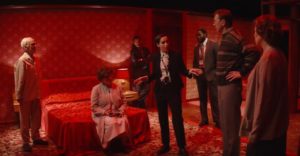 The show doesn’t stick to the same visual stylings and instead introduces new elements frequently, which work or fail on a case-by-case basis. Why is the first scene of the third episode colour-graded to have a weird purple filter? I have no idea, none of the other scenes continue this, but I quite like it, mainly because it’s not an overused blue or yellow filter. Email correspondence is shown dynamically as characters appearing in the world to monologue what they have written. Even the credits offer something interesting, combining real news reports with the construction of the sets used in the show: both being the formation of the series. The weird impressionistic shots of characters looking like they are moving just as a photograph is taken, leaving bright trails, I’m less impressed by because… why? Unlike the purple scenes, there is no narrative progression, just a cool visual for the sake of it, and this is coming from someone who usually loves pretentious arty stuff. I want David Lynch to direct everything. There are just scenes and shots included because the director thought they were clever. Pure style over substance. And then there are the random shots of Susan running in a field as a child, which feel so trite.
The show doesn’t stick to the same visual stylings and instead introduces new elements frequently, which work or fail on a case-by-case basis. Why is the first scene of the third episode colour-graded to have a weird purple filter? I have no idea, none of the other scenes continue this, but I quite like it, mainly because it’s not an overused blue or yellow filter. Email correspondence is shown dynamically as characters appearing in the world to monologue what they have written. Even the credits offer something interesting, combining real news reports with the construction of the sets used in the show: both being the formation of the series. The weird impressionistic shots of characters looking like they are moving just as a photograph is taken, leaving bright trails, I’m less impressed by because… why? Unlike the purple scenes, there is no narrative progression, just a cool visual for the sake of it, and this is coming from someone who usually loves pretentious arty stuff. I want David Lynch to direct everything. There are just scenes and shots included because the director thought they were clever. Pure style over substance. And then there are the random shots of Susan running in a field as a child, which feel so trite.
The final episode consists of a western retelling of the story as Susan sees it, her and her hero husband on the run from the lawmen, and it’s wonderful. It’s a successful showing of what the whole series was trying to do: a subjective perspective, an enjoyable stylistic departure from standard true crime tales, and a metaphor to be analysed. For a very British series to suddenly embrace the American western is great fun, something Stephen Merchant’s The Outlaws attempted, although far less directly. For a time, the western also contrasts well with the black-and-white sterile trial, offering a glimpse of how good the whole series could have been with a bit more restraint. While a surrealist technique often detracts from the show every few minutes, this cowboy sequence is the longest period of time the show nails what it is attempting without a mistake. The second best being the ending of the first episode with Susan and Christopher on the train, combining drama, comedy, and quirk perfectly.
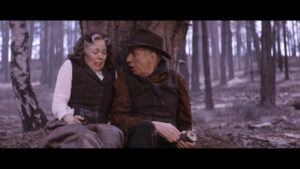 When Landscapers works, it really works. Which makes me disappointed I don’t love the show as much as I want to. It’s a brilliantly conceived idea that just gets lost in its own surreal execution too often. It’s trying so very hard to be unique and Will Sharpe throws every single stylistic idea he has into it, some of which pay off and some of which don’t. Thankfully the series nails its final scene, Susan and Christopher reunited in an imagined dream film of their own making, love prevailing, as they ride off into the sunset only for the rear projection to stop and the clear artificiality of the moment becoming brutally and artfully clear.
When Landscapers works, it really works. Which makes me disappointed I don’t love the show as much as I want to. It’s a brilliantly conceived idea that just gets lost in its own surreal execution too often. It’s trying so very hard to be unique and Will Sharpe throws every single stylistic idea he has into it, some of which pay off and some of which don’t. Thankfully the series nails its final scene, Susan and Christopher reunited in an imagined dream film of their own making, love prevailing, as they ride off into the sunset only for the rear projection to stop and the clear artificiality of the moment becoming brutally and artfully clear.
What are your thoughts on Landscapers? Let me know in the comments and be sure to geek out with me about TV, movies and video-games on Twitter @kylebrrtt.




